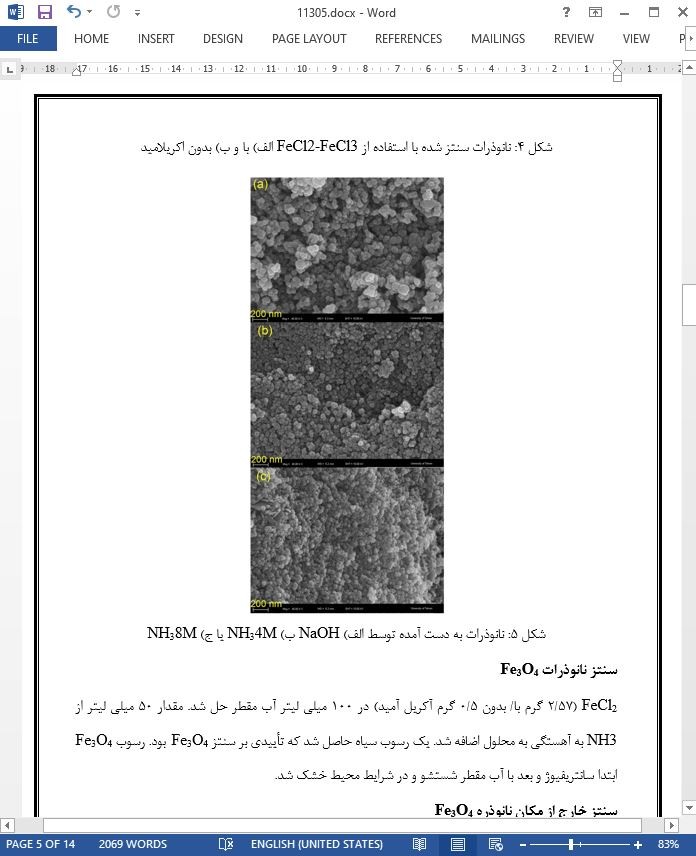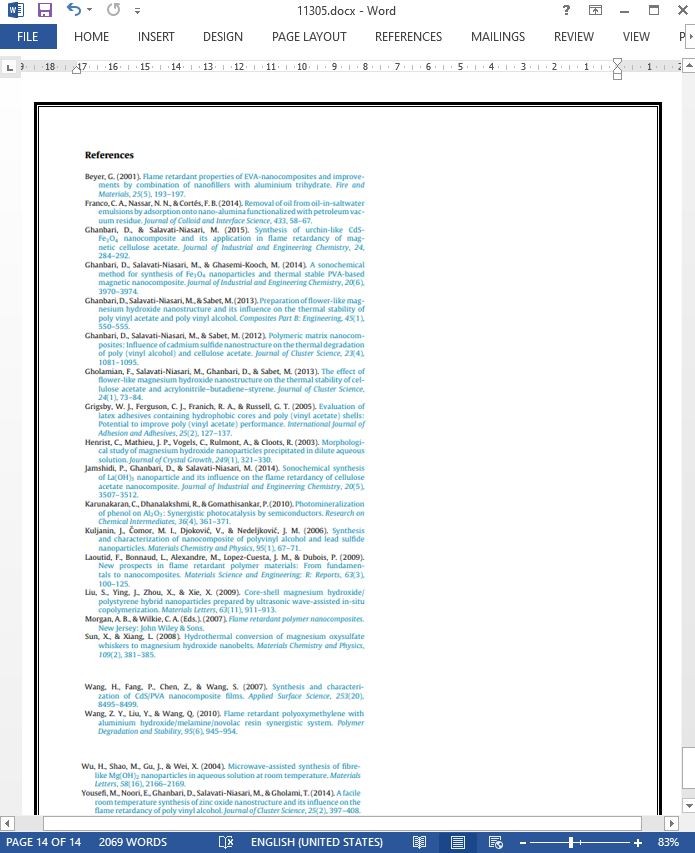
سنتز در محل و خارج از محل پلی (وینیل الکل) – Fe3O4 نانوکامپوزیت پیشگیرنده شعله
چکیده
استفاده از پیش گیرنده های شعله به علت الزامات زیست محیطی محدود می باشد. این مقاله نانوذرات مغناطیسی معمولی را به عنوان یک کلاس جدید غیر سمی و پیش گیرنده شعله معرفی می کند. نانو ذره Fe3O4 هر دو خصوصیت مقاومت حرارتی و پیش گیرندگی در مقابله شعله ماتریس پلی (وینیل الکل) را افزایش می دهد. نانو ذرات از طریق یک واکنش رسوب دهنده بدون استفاده از هیچ گونه گاز بی اثر در دمای اتاق سنتز می شوند. اثر پیش ماده های متفاوت و آکریل آمید بر روی فورمولوژی محصولات مورد بررسی قرار می گیرد. نانوذرات یک رفتار فریمغناطیس را در دمای اتاق از خود نشان دادند. برای تهیه نانوکامپوزیت مغناطیسی، نانوذرات Fe3O4 به پلی (وینیل الکل) اضافه شد. در حضور شعله، نانوذرات مغناطیسی در کنار یکدیگر باقی ماندند. نانوذرات پراکنده نقش یک لایه مانع مغناطیسی را بازی می کردند که سرعت تبخیر مواد را کم می کرد و مانعی جلوی شعله های آتش بود و از رسیدن اکسیژن به نمونه در طول تجزیه پلیمر جلوگیری می کرد.
مقدمه
در سال های اخیر استفاده از نانومواد مغناطیسی در کارهای مختلف مانند جذب اشعه مایکروویو، تشخیص های بالینی، جداسازی مواد معدنی، مواد مغناطیسی نوری، تجهیزات ذخیره سازی، و فیلترهای مایکروویو مورد توجه بوده است. مگنتیت (Fe3O4) به علت انقال الکترون بین Fe2+ و Fe3+ خاصیت مغناطیسی و الکتریکی منحصر به فردی را در یک مدل هشت وجهی نشان می دهد. به علت سازگاری آنها با محیط زیست، سمیت پایین، قابلیت تنظیم خاصیت مغناطیسی، Fe3O4 در سال های اخیر توجه زیادی را به خود جلب نموده است و در کاربردهایی همچون هدف قرار دادن دارو، درمان سرطان، جدایی سلول های مغناطیسی، تجزیه آنزیم ساکن، سیستم های تبرید مغناطیسی، و کاربردهای انتقال حرارت به کار گرفته میشوند. به علت اینکه خصوصیات نانو کریستال ها وابسته به ترکیب، شکل، اندازه، ساختار و فاز آنها است نانوساختارها به شدت در مطالعات امروزی مورد بررسی قرار می گیرند. واکنش و انتخاب نانوذرات می تواند با کنترل مورفولوژی تنظیم شود زیرا سطح در معرض ذرات دارای سطوح بلورشناختی مجزا و وابسته به شکل هستند.
نتیجه گیری
نانوذرات Fe3O4 از طریق یک واکنش رسوب زا در دمای اتاق بدون استفاده از هوای بی اثر سنتز شدند. نانوذرات با استفاده از تکنیک های XRD، SEM، TEM، EDS و AFM مشخص شدند. اثر پارامترهای مختلف مانند پیش ماده و کاهش عامل بر مورفولوژی محصولات مورد بررسی قرار گرفت. نانوذرات Fe3O4 از خود رفتار فری مغناطیسی با اشباع مغناطیسی 4/48 و وادارندگی 2/50 را در دمای نشان دادند. نتایج نشان می دهد که این نانوفیلترهای غیرسمی ثبات حرارتی و بازدارندگی در مقابل شعله PVA را بهبود می بخشند.
Abstract
Application of flame retardants is limited because of environmental requirements. This work introduces conventional magnetic nanoparticles as a new class of nontoxic and effective flame retardant. Fe3O4 enhanced both the thermal stability and flame retardant properties of a poly(vinyl alcohol) matrix. Nanoparticles were synthesized via a simple precipitation reaction without using an inert atmosphere at room temperature. The effects of different precursors and acrylamide on the morphology of the products were investigated. Nanoparticles exhibited a ferrimagnetic behavior at room temperature. To prepare the magnetic nanocomposite, Fe3O4 nanoparticles were added to the poly(vinyl alcohol). In the presence of a flame, the magnetic nanoparticles remained together, showed resistance to dripping and protected the polymer matrix. Dispersed nanoparticles play a role of a magnetic barrier layer, which slows product volatilization and prevents flames and oxygen from reaching the sample during decomposition of the polymer.
Introduction
Magnetic nanomaterials have attracted attention in various applications such as the absorption of microwave radiation, clinical diagnosis, mineral separation, magneto-optic materials, magnetic storage devices, and microwave filters. Magnetite (Fe3O4) exhibits unique electric and magnetic properties because of the transfer of electrons between Fe2+ and Fe3+ in the octahedral sites. Because of their biocompatibility, low toxicity, and adjustable magnetic properties, Fe3O4 have received considerable attention in various areas such as drug targeting, cancer therapy, magnetic cell separation, enzyme immobilization catalysis, magnetic refrigeration systems, and heat transfer applications (Ghanbari, Salavati-Niasari, & Ghasemi-Kooch, 2014; Gholamian, Salavati-Niasari, Ghanbari, & Sabet, 2013). Nanostructures have been intensively studied in a wide range of applications because the properties of nanocrystals depend on their composition, shape, size, structure, phase, and size distribution. The reactivity and selectivity of nanoparticles can be adjusted by controlling the morphology because the exposed surfaces of the particles have distinct crystallographic planes depending on the shape (Ghanbari, Salavati-Niasari, & Sabet, 2012; Kuljanin, Comor, ˇ Djokovic, ´ & Nedeljkovic, ´ 2006; Morgan & Wilkie, 2007; Sun & Xiang, 2008; Wang, Liu, & Wang, 2010).
Conclusions
Fe3O4 nanoparticles were synthesized via a precipitation reaction at roomtemperature without using an inert atmosphere. Fe3O4 Nanoparticles were characterized using XRD, SEM, TEM, EDS, and AFM techniques. The effects of different parameters such as precursor and reducing agent on the morphology of the products were investigated. The Fe3O4 nanoparticles exhibit ferrimagnetic behavior with a saturation magnetization of 48.4 emu/g and a coercivity of 50.2 Oe at room temperature. Coercivity was increased by the formation of the nanocomposite and distribution of the Fe3O4 into PVA. The results show that these nontoxic nanofillers improve the thermal stability and flame retardancy of the PVA matrix.
چکیده
مقدمه
تجربی
مواد و ابزار
سنتز نانوذرات Fe3O4
سنتز خارج از مکان نانوذره Fe3O4
سنتز در جا نانو کامپوزیت PVA- Fe3O4
نتایج و بحث
نتیجه گیری
abstract
Introduction
Experimental
Materials and instruments
Synthesis of Fe3O4 nanoparticles
Ex situ synthesis of PVA–Fe3O4 nanocomposites
In situ synthesis of PVA–Fe3O4 nanocomposites
Results and discussion
Conclusions
- اصل مقاله انگلیسی با فرمت ورد (word) با قابلیت ویرایش
- ترجمه فارسی مقاله با فرمت ورد (word) با قابلیت ویرایش، بدون آرم سایت ای ترجمه
- ترجمه فارسی مقاله با فرمت pdf، بدون آرم سایت ای ترجمه



